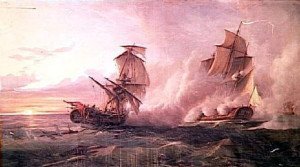Fox v Junon 10 September1778
In early September, the British frigate Fox 28, Captain Hon. Thomas Windsor, was despatched by the commander-in-chief of the Grand Fleet, Admiral Hon. Augustus Keppel, to search for the French fleet, which was then believed to be at sea in the vicinity of Cape Finisterre.
The Fox had first been commissioned in 1775 and was armed with twenty-four 9-pounder cannons on her upper deck and four 3-pounder cannons on her quarterdeck, equating to a broadside weight of metal of one hundred and fourteen pounds. She had a nominal compliment of two hundred men. In her short career she had been captured by, and then retaken from, the American rebels, and after returning to England she had been coppered at Portsmouth in the spring of 1778. Here she had been joined by the newly posted Captain Windsor, who was the 25-year-old son of the Earl of Plymouth. After joining the Grand Fleet and witnessing the Battle of Ushant on 27 July, she had spent a fruitful period cruising off the French coast, with the newspapers proudly reporting that she had ‘in some measure regained her character’.

The Junon batters the Fox into submission
On 10 September the Fox was off Brest in chase of two vessels when she became aware of a heavier frigate approaching her in the thick and squally weather to the north-east. She accordingly took in sail to await the stranger, which vessel proved to be the newly commissioned twelve-pounder French frigate Junon 32, Captain Antoine-François de Beaumont, the Vicomte de Beaumont Haunt. With a crew of some three hundred and thirty men, the Junon sported twenty-six upper deck 12- pounder cannons and an additional six 6-pounder cannons on her forecastle and quarterdeck, giving her a broadside weight of one hundred and seventy-four pounds, and thereby a superiority over the Fox. Her commander, the 45-year-old de Beaumont, was ill at this time, but he had himself brought up on deck to supervise the forthcoming encounter.
Both ships having established a resolve to fight, there began a series of manoeuvres which resulted in the antagonists exchanging broadsides as they passed on opposite tacks. The French vessel then tried to obtain a raking position over the Fox, and when this move was thwarted, she attempted to come down from to windward on her opponent’s quarter. Although this manoeuvre did not provide her with any greater ascendancy over her opponent, her heavier firepower at short range did. Somewhat unusually for a French vessel, she directed her fire into the British hull rather than at her rigging, and the Fox soon began to suffer from the superiority of her opponent’s broadsides.
At length, having withstood the Junon’s cannon for three and a half hours, but being totally dis-masted and with most of his cannons out of action, Captain Windsor waved his hat to signal his surrender. At that stage the Fox was barely able to return her opponent’s fire, and she had suffered eleven men killed and thirty-eight wounded, the latter figure including Windsor who had been badly hurt by a musket ball in the right arm and had suffered four other minor injuries. The Junon was in a much better condition and had only lost four men killed and fifteen wounded.
The captured Fox was taken into Brest where her casualties received exemplary treatment from the French authorities. Despite having the musket ball extracted ashore on the 19th, Captain Windsor’s wounds were such that he was unable to write, and so it was left to his first lieutenant, the future Admiral Sir Albemarle Bertie, to compose a despatch to the Admiralty on 20 September from his imprisonment aboard the Fox.
By 25 September rumours were circulating in the City of London that the Fox had been captured and taken into Brest, and shortly afterwards reports attributed to the French press stated that she had been captured by a 50-gun vessel, having lost forty men killed. Other accounts stated that Captain Windsor had been killed in the engagement, but all was clarified in the second week of October with the publication of Lieutenant Bertie’s letter to the Admiralty.
In January 1779 Windsor and Bertie were allowed to return to England on parole following the intervention in Paris of Lieutenant-General Hon. William Keppel, who desired both men to appear as witnesses at the court-martial of his brother, Admiral Hon. Augustus Keppel, conversant with the fall-out from the Battle of Ushant. Having given evidence in favour of Keppel and having also attended Vice-Admiral Sir Hugh Palliser’s court-martial in April, Windsor returned to France at the end of June in line with his parole of honour. Released again in January 1780, and having been acquitted at his own court-martial for the loss of the Fox, he commissioned a new 32-gun frigate in April which was also named the Fox in honour of his gallant defence.
Meanwhile the captured Fox had not lasted long in the French service, for on 22 March 1779 she had driven aground off Brittany with no hope of salvage. The Junon lasted but a year and a half longer before she was lost during the ‘Great Hurricanes’ of October 1780, which also claimed so many British ships in the Leeward Islands. Following the French Revolution, the victorious Captain de Beaumont would come to seek refuge in both England and Russia before returning to his homeland, where he died in 1805 during the early days of Napoleon’s Empire. Captain Windsor did not see any further service after the American War of Independence, and he resigned in 1795 upon being passed over for flag rank.
